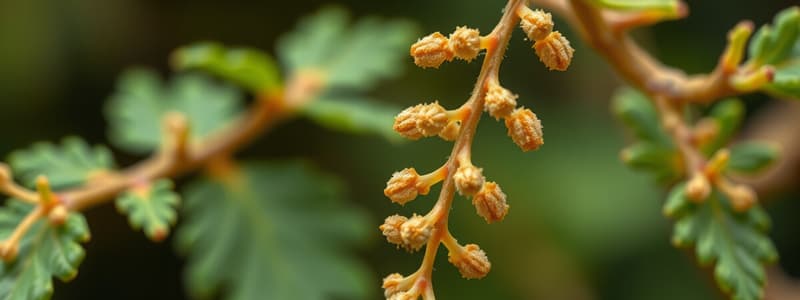Podcast
Questions and Answers
What is the primary role of lignin in plants?
What is the primary role of lignin in plants?
- Energy production
- Photosynthesis
- Nutrient storage
- Mechanical matrix and moisture barrier (correct)
Lignin can be fully utilized with no wastage in commercial applications.
Lignin can be fully utilized with no wastage in commercial applications.
False (B)
What is the average molecular weight range of lignin fragments obtained through pulping processes?
What is the average molecular weight range of lignin fragments obtained through pulping processes?
About a thousand to tens of thousands.
Lignin is primarily composed of _____ monomer precursors.
Lignin is primarily composed of _____ monomer precursors.
What is a current challenge regarding lignin utilization?
What is a current challenge regarding lignin utilization?
Match the following aspects of lignin with their corresponding descriptions:
Match the following aspects of lignin with their corresponding descriptions:
Research on lignin exploitation has seen significant economic success.
Research on lignin exploitation has seen significant economic success.
What is the typical exploitation percentage of available lignin for production?
What is the typical exploitation percentage of available lignin for production?
What are the potential uses of lignin as a macromonomer?
What are the potential uses of lignin as a macromonomer?
Lignin has a consistent structure regardless of its source.
Lignin has a consistent structure regardless of its source.
What novel process enhances control over the structure and molecular weight of lignin fragments?
What novel process enhances control over the structure and molecular weight of lignin fragments?
The reaction called __________ converts lignin fragments into viscous polyols suitable for polyurethane production.
The reaction called __________ converts lignin fragments into viscous polyols suitable for polyurethane production.
Match the following lignin-based applications with their descriptions:
Match the following lignin-based applications with their descriptions:
What is a significant challenge in using lignin as a polymer precursor?
What is a significant challenge in using lignin as a polymer precursor?
Vanillin can be used directly as a polymer without any modification.
Vanillin can be used directly as a polymer without any modification.
What is one of the benefits of using lignin-derived materials compared to traditional fossil-based polyols?
What is one of the benefits of using lignin-derived materials compared to traditional fossil-based polyols?
The molecular weight of lignin fragments after biorefinery processing is around __________ Da.
The molecular weight of lignin fragments after biorefinery processing is around __________ Da.
Match the monomers with their intended applications:
Match the monomers with their intended applications:
Which process enhances the use of lignin for producing polyurethane foams?
Which process enhances the use of lignin for producing polyurethane foams?
The incorporation of lignin in adhesives aims to increase the usage of formaldehyde.
The incorporation of lignin in adhesives aims to increase the usage of formaldehyde.
What does the term 'macromonomer' refer to in the context of lignin?
What does the term 'macromonomer' refer to in the context of lignin?
Research into lignin-based materials is contributing to the growth of ________ resources.
Research into lignin-based materials is contributing to the growth of ________ resources.
Match the following lignin-based technologies with their characteristics:
Match the following lignin-based technologies with their characteristics:
Flashcards are hidden until you start studying
Study Notes
Lignin Overview
- Lignin is a major plant polymer serving as a mechanical matrix and moisture barrier for cellulose fibers.
- Its complex macromolecular structure is formed from three fundamental monomer precursors, represented by the classical C9 unit with variable substitutions.
Lignin Utilization and Challenges
- Less than 2% of lignin is currently utilized for producing profitable chemicals.
- The pulping industry primarily burns lignin by-products for energy recovery, leaving significant untapped potential.
- Research into lignin-derived commodities has been limited by modest economic and technological drivers.
Applications of Lignin as Macromonomers
- Lignin contains both aliphatic and phenolic hydroxyl groups, making it suitable for synthesizing polyesters, polyurethanes, and polyethers.
- Challenges arise due to steric hindrance affecting access to reactive moieties and variability in molecular weight and structure of lignin fragments.
Advances in Lignin Processing
- A novel biorefinery organosolv process yields lignin fragments with molecular weights around 1000 Da, enhancing their suitability as macromonomers.
- Oxypropylation converts lignin fragments into viscous polyols, ideal for producing polyurethane foams comparable to fossil-based alternatives.
Research Developments in Lignin-based Products
- Vanillin extraction from lignin has been optimized, showing potential as an economically valuable compound.
- Vanillin electropolymerization is viable, producing dimers with degrees of polymerization (DPs) between 30-40.
- Acrylated vanillin reacts with glycerol dimethacrylate to create a crosslinked vinyl ester resin with strong mechanical properties.
Innovative Monomer Alternatives
- Vanillic acid can be epoxidized, offering a renewable monomer option to replace bisphenol-A in epoxy resins.
- Various aromatic polymers have been synthesized from vanillin and vanillic acid, simulating widely used polyesters.
Lignin in Adhesives and Copolymers
- Recent advancements have incorporated lignin into wood adhesives, using calcium lignosulfonate and glyoxal to minimize formaldehyde use.
- Lignin grafted with poly(N-isopropylacrylamide) showcases hydrophilic-hydrophobic transitions due to thermal configurational changes.
- Copolymers formed with poly(butadiene) display interesting mechanical properties.
Lignin-based Polyurethanes
- Novel investigations into lignin-based polyurethanes highlight the potential of renewable resource polymers.
- Lignin's abundant and inexpensive nature presents significant opportunities for driving advancements in sustainable polymer technology.
Studying That Suits You
Use AI to generate personalized quizzes and flashcards to suit your learning preferences.




